Flavorful Roasted Butternut Squash with Sage & Walnuts: Your Essential Fall Side Dish
Embrace the cozy flavors of autumn with this incredibly easy and delicious roasted butternut squash, perfectly tossed with aromatic butter, fresh sage, and crunchy toasted walnuts. It’s the ideal side dish to elevate any fall meal.
As the crisp, cool air of autumn arrives, our thoughts naturally turn to comforting dishes that warm us from the inside out. This season heralds the return of hearty stews, slow-cooked meals, and, of course, a delightful array of squash and pumpkin recipes. There’s an undeniable charm to butternut squash, especially when paired with fresh herbs, that instantly evokes the essence of fall comfort food. It’s a versatile vegetable that transforms into a tender, sweet, and savory delight with minimal effort, making it a staple in many kitchens during this time of year.
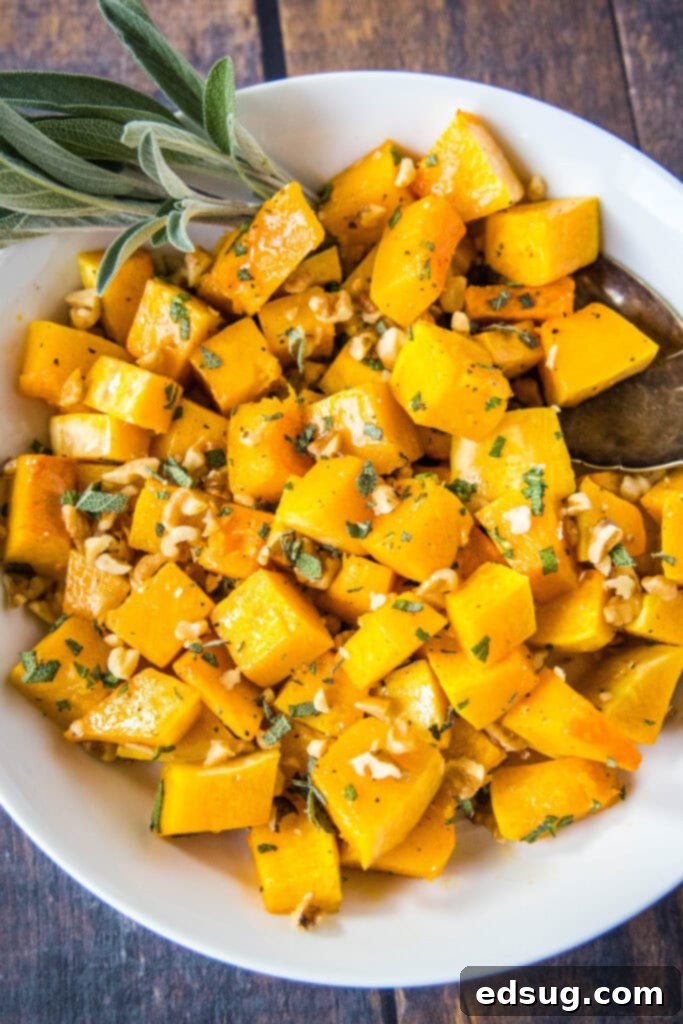
This roasted butternut squash recipe is a testament to simplicity and flavor. It’s incredibly easy to prepare and offers a fantastic canvas for customization. While fresh sage adds an earthy, aromatic note that perfectly complements the squash’s natural sweetness, you can easily substitute it with other favorite herbs like thyme, rosemary, or even a hint of oregano if you prefer. The beauty of this dish lies in its adaptability and its ability to deliver a sophisticated flavor profile with very little fuss, making it perfect for both busy weeknights and special holiday gatherings.
Beyond its wonderful taste, this versatile side dish pairs beautifully with a wide variety of main courses. Whether you’re serving up savory Taco Meatballs, tender Slow Cooker Steak Bites, or classic Baked Ranch Chicken, this roasted butternut squash will complement your meal exquisitely. Its delightful combination of sweet, savory, and nutty flavors makes it a universal crowd-pleaser that effortlessly enhances any plate.
Why Roasted Butternut Squash is a Fall Favorite
Butternut squash truly shines in the cooler months, becoming a star ingredient in many autumn recipes. Its rich, sweet, and slightly nutty flavor intensifies beautifully when roasted, caramelizing its natural sugars and creating a tender, melt-in-your-mouth texture. This transformation makes it an irresistible addition to any fall menu. Paired with aromatic sage and crunchy walnuts, it becomes a multi-dimensional dish that embodies the very essence of seasonal eating. It’s not just a side; it’s an experience that brings warmth and comfort to your table, making it a beloved tradition for many families as soon as leaves start to change color.
The Nutritional Benefits of Butternut Squash
Beyond its delightful taste, butternut squash is a powerhouse of nutrition, making it an excellent choice for a healthy diet. It’s packed with vitamins, minerals, and fiber. Specifically, it’s an exceptional source of Vitamin A (in the form of beta-carotene), which is crucial for vision, immune function, and skin health. It also provides a good amount of Vitamin C, vital for immunity and collagen production, and a significant boost of potassium, important for blood pressure regulation. Furthermore, the fiber content aids in digestion and can contribute to a feeling of fullness, making it a satisfying and beneficial addition to your meals. Adding walnuts to this recipe further enhances its nutritional profile with healthy fats, protein, and more fiber.
Essential Ingredients for Your Butternut Squash
You’ll be amazed at how a few simple ingredients combine to create such a spectacular dish. Be sure to scroll to the bottom of the post for the FULL PRINTABLE recipe card with exact measurements.
- Butternut Squash: This vibrant, bell-shaped squash is the undisputed star of our recipe. When selecting your squash, look for one that is firm, heavy for its size, and free of soft spots or blemishes. A deep, uniform color indicates ripeness.
- Non-stick Spray (or Olive Oil): Essential for preventing the squash from sticking to the baking sheet and helping it roast evenly without drying out. You can also use a light drizzle of olive oil, avocado oil, or melted coconut oil for similar results and added flavor.
- Salt: A touch of salt is crucial to enhance the natural sweetness of the butternut squash and balance the overall flavors. Don’t underestimate its power in bringing out the best in roasted vegetables.
- Black Pepper: Freshly ground black pepper adds a subtle warmth and a gentle “kick” that perfectly complements the squash’s earthy notes.
- Butter: Melted butter brings an irresistible richness and a creamy mouthfeel, helping the sage cling beautifully to each piece of squash. For a dairy-free or vegan option, feel free to use a plant-based butter alternative.
- Chopped Walnuts, Toasted: These provide a delightful textural contrast with their satisfying crunch against the tender squash. Toasting the walnuts beforehand truly unlocks their deep, nutty flavor, adding a layer of complexity to the dish. Pecans are also a fantastic alternative if you prefer.
- Fresh Sage, Finely Chopped: This aromatic herb is a surprising yet essential addition, infusing the dish with its distinct, earthy, and slightly peppery flavor. While dried sage can be used in a pinch, fresh sage delivers a significantly more vibrant and fragrant experience that elevates the entire dish.
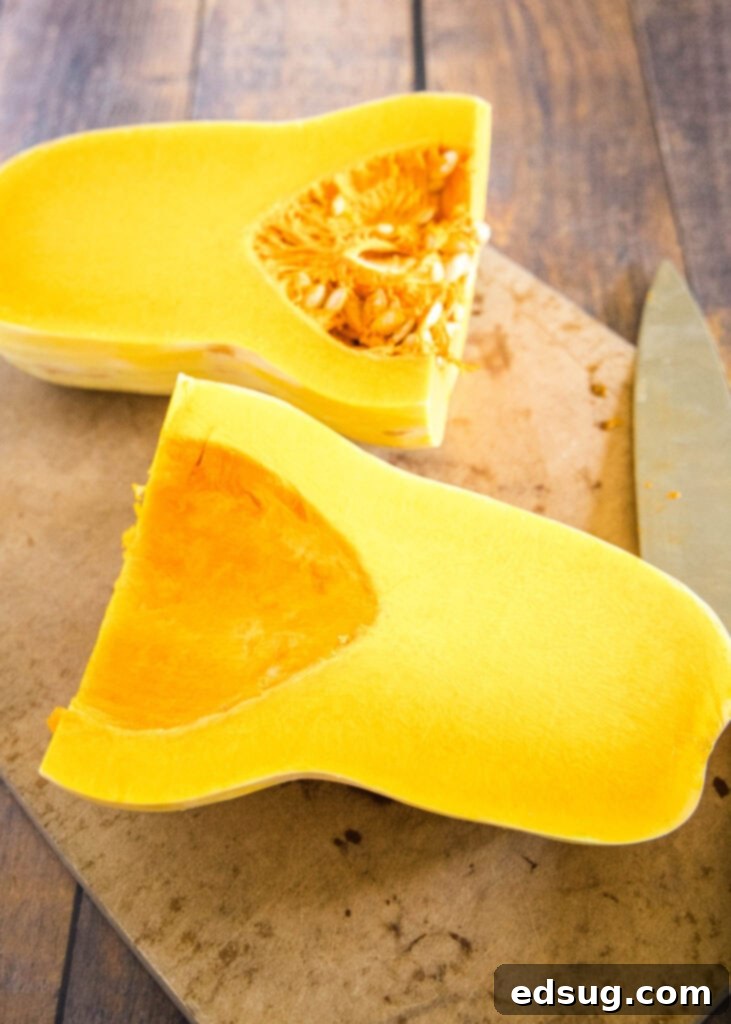
How to Make Perfect Roasted Butternut Squash
Get ready to be amazed at just how incredibly simple and straightforward this butternut squash recipe is. With only a few easy steps, you’ll achieve a hands-off side dish that is not only delicious but also wonderfully nutritious, making it a perfect addition to any meal.
- Preheat Your Oven Thoroughly: Begin by preheating your oven to 425°F (220°C). Allowing the oven to reach its full temperature before placing your squash inside is crucial for proper roasting. This initial burst of heat ensures the squash starts cooking immediately, leading to a perfectly tender interior and slightly caramelized exterior. If the oven isn’t fully preheated, the cooking time listed may not be sufficient for the butternut squash to cook through to that desired tender consistency.
- Prepare and Season the Squash: Carefully peel your butternut squash (see notes below on peeling options) and then cut it into uniform 1-inch cubes. The key to even cooking is to make sure your cubes are as close to the same size as possible. Spread the cubed squash onto a large baking sheet in a single layer. Overcrowding the pan can lead to steaming instead of roasting, resulting in soggy squash. Give it a generous spray with non-stick spray (or drizzle with olive oil), then sprinkle evenly with salt and freshly ground black pepper. Toss everything gently with your hands or a spatula to ensure every piece is well-seasoned and coated.
- Roast Until Tender and Golden: Transfer the baking sheet to your preheated oven and bake for 20-25 minutes. Roasting times can vary slightly depending on the size of your squash cubes and the nuances of your oven, so it’s a good idea to start checking for doneness around the 20-minute mark. The squash is perfectly roasted when it’s fork-tender and has developed a beautiful, slightly browned and caramelized exterior. A little char on the edges adds fantastic flavor!
- Finish with Flavorful Toppings: Once roasted to perfection, remove the baking sheet from the oven. Immediately add the melted butter, toasted chopped walnuts, and finely chopped fresh sage over the warm squash. Toss everything together gently until the squash is glistening with butter and the walnuts and sage are evenly distributed. The warmth of the squash will help the butter melt beautifully and infuse the sage’s aroma throughout. Serve this delightful dish immediately, as the warm, melty butter and fragrant sage are best enjoyed hot, providing an exquisite depth of flavor.
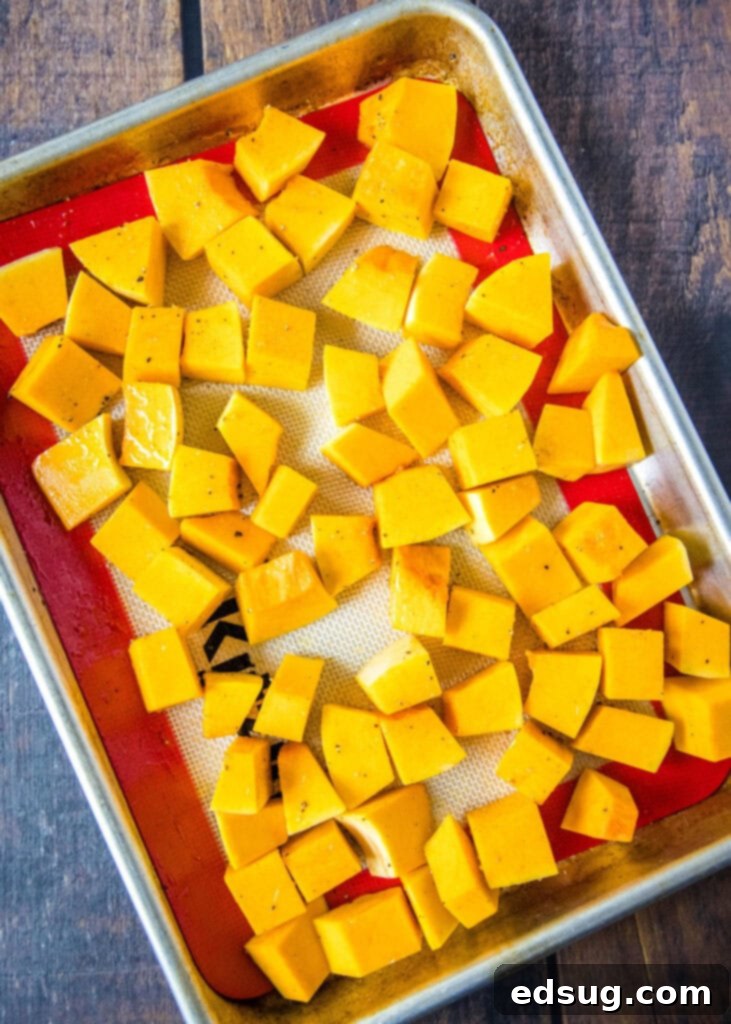
To Peel or Not to Peel Butternut Squash Before Roasting?
When it comes to roasting butternut squash, deciding whether or not to remove the peel is entirely up to personal preference. The uncooked peel can be quite tough and difficult to cut through. However, once roasted, the skin of butternut squash becomes surprisingly tender and is completely edible. Many people choose to leave it on, as it can add a slightly rustic texture and save preparation time.
That being said, if you’re dealing with picky eaters, children, or individuals who have texture aversions, you might consider peeling the butternut squash before you cube and roast it. The texture of the roasted peel, while soft, is distinctly different from the creamy interior of the squash. Removing it ensures a uniformly smooth and tender eating experience, which can make it easier to convince beginners or those with discerning palates to try (and love!) this delicious vegetable. You can use a sturdy vegetable peeler or a sharp knife to carefully remove the skin. If using a knife, be extra cautious as the squash can be slippery.
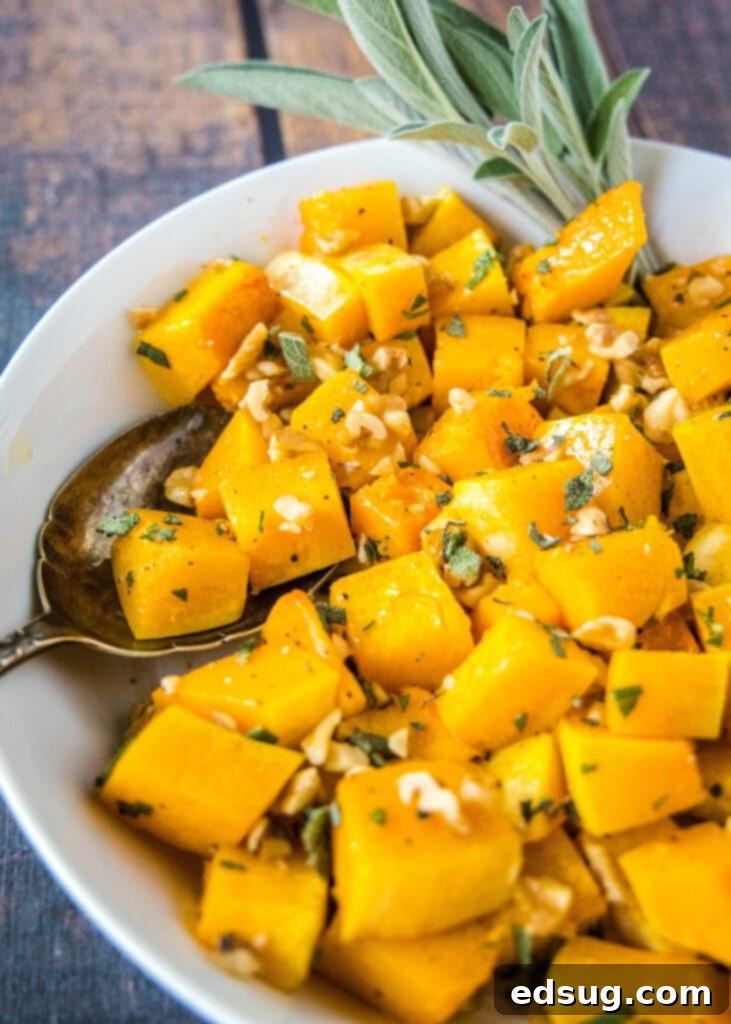
Butternut Squash: A Healthy Low-Carb Alternative?
While I’ve always focused on deliciousness over strict carb counting in my cooking, I understand that many people follow low-carb or ketogenic lifestyles. For those watching their carbohydrate intake and searching for a fantastic substitute for traditional potatoes, roasted butternut squash is an excellent and highly recommended option.
The wonderfully tender and slightly starchy texture of roasted butternut squash is remarkably similar to that of roasted potatoes, yet it boasts a significantly lower carbohydrate count. A half-cup serving of roasted butternut squash contains only about 7.5 net carbs, making it a much lighter choice. This recipe also incorporates walnuts, which are not only low in carbs but also rich in healthy fats and beneficial nutrients. So, you can absolutely enjoy this flavorful side dish as written (in moderation, as with any food) and stay well on track with your low-carb lifestyle, without sacrificing taste or satisfaction. It’s a smart choice for a balanced and delicious meal.

Expert Tips for Perfect Roasted Butternut Squash
This roasted butternut squash recipe is so wonderfully simple that you might chuckle at the idea of needing tips or tricks. However, my goal is always to help you achieve perfect results on your very first try. Follow these expert recommendations to ensure you fall in love with this dish from the very first bite:
- Peel for Faster Cooking and Smoother Texture: While the skin is edible once roasted, peeling your butternut squash will allow it to cook slightly faster and result in a uniformly smooth and tender texture throughout. If time is a factor or you prefer a silkier mouthfeel, peel away!
- Cut into Uniform Cubes: Consistency is key! Aim to cut your butternut squash into pieces that are as close to the same size as possible, ideally around 1-inch cubes. This ensures that every piece cooks evenly, so you won’t have some bits still hard while others are overly soft.
- Don’t Skimp on the Toppings: The combination of rich butter, aromatic sage, and crunchy walnuts is what truly makes this dish shine. These finishing touches add immense flavor and textural contrast, elevating simple roasted squash to something extraordinary.
- Prioritize Fresh Sage: Whenever possible, opt for fresh sage over dried. Fresh sage boasts a much more vibrant, earthy, and delicious flavor that significantly impacts the overall taste of the dish. Store fresh sage in the refrigerator, wrapped in a damp paper towel, to keep it fresh longer.
- Avoid Overcrowding the Baking Sheet: For truly roasted (not steamed) squash, ensure the cubes are spread in a single layer on the baking sheet with a little space between them. If your baking sheet is too crowded, the squash will steam rather than caramelize, leading to a softer, less flavorful result. Use two baking sheets if necessary.
- Experiment with Spices: While salt and pepper are fundamental, feel free to add other spices to customize the flavor. For a sweeter profile, a pinch of cinnamon or nutmeg can be lovely. For a more savory kick, a dash of garlic powder or smoked paprika can add exciting depth.
- Toast Walnuts Separately: For the best flavor and crunch, lightly toast your chopped walnuts in a dry pan over medium heat for a few minutes, or in the oven for 5-7 minutes before adding them to the squash. This brings out their natural oils and enhances their nutty taste significantly.
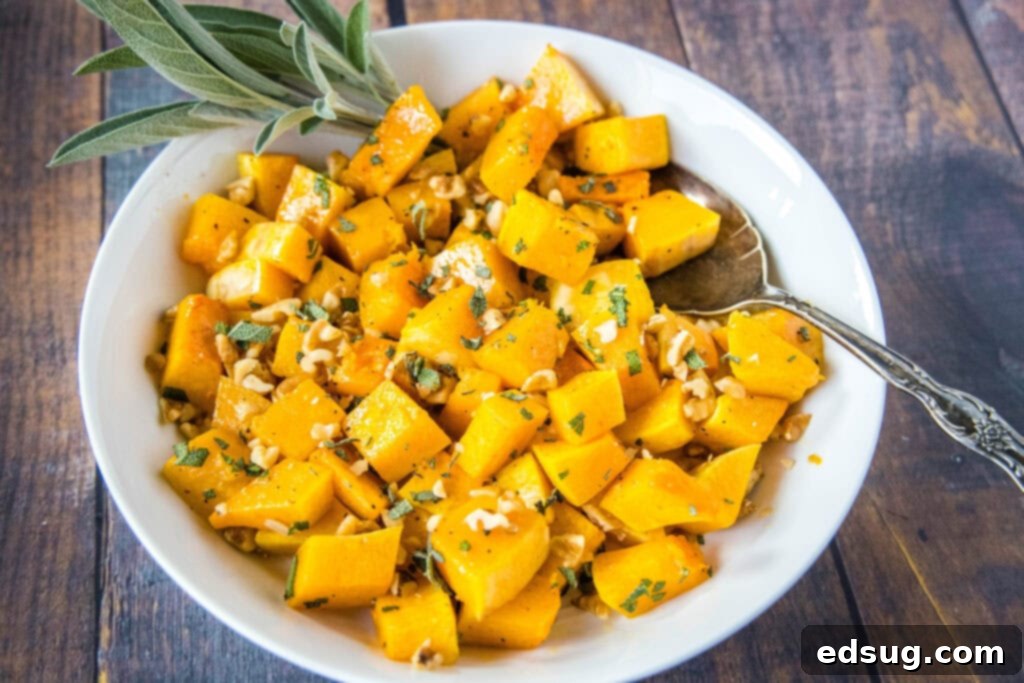
What to Serve with Roasted Butternut Squash
This Roasted Butternut Squash recipe is incredibly versatile and makes the perfect side dish to serve with virtually any of your favorite protein-packed main courses. Its sweet and savory notes beautifully complement both meat and poultry. Here are a few of my top dinner recipes that pair wonderfully with this autumnal side:
- Smoked Chicken Legs: The smoky flavor of chicken legs creates a fantastic contrast with the sweet squash.
- Sous Vide Lamb Chops: The rich, tender lamb finds a perfect companion in the earthy sweetness of the squash.
- Grilled Pork Chops: A classic pairing, the savory pork and sweet squash are a match made in heaven.
- Grilled Chicken Sandwich: Serve the squash alongside this sandwich for a more substantial and balanced meal.
- Chick Fil-A Chicken Nuggets: A family-friendly option, the squash adds a healthy and delicious vegetable component.
- Holiday Roasts: This dish is also an absolute must-have for Thanksgiving, Christmas, or any festive fall gathering, pairing excellently with roasted turkey or ham.
Meal Prep and Storage Tips
For those with busy lifestyles who appreciate the convenience of meal prepping, roasted butternut squash is an excellent choice. It holds up well and can be prepared in advance, making your weeknight dinners or holiday meal assembly much easier. To ensure the freshest and most vibrant flavors when reheating, I recommend keeping the roasted butternut squash separate from the melted butter, toasted walnuts, and fresh sage.
To store your roasted butternut squash, simply place the cooled squash in an airtight container and refrigerate it. When stored properly, this hearty vegetable typically retains its quality for 3-5 days after roasting. When you’re ready to enjoy it, reheat the squash gently in the oven or microwave, then toss it with freshly melted butter, newly toasted walnuts, and freshly chopped sage for that delicious, just-made taste and texture. This method prevents the walnuts from becoming soggy and the sage from losing its fresh aroma during storage.
Explore More Delicious Squash Recipes
If you’ve fallen in love with the versatility and flavor of butternut squash, you’ll be thrilled to discover how many other wonderful dishes you can create with various types of squash. From hearty risottos to comforting soups and inventive salads, squash offers endless culinary possibilities. Here are some more of my favorite squash recipes to inspire your cooking:
- Butternut Squash Risotto: Creamy, rich, and full of autumnal flavor.
- Roasted Squash and Goat Cheese Salad: A refreshing and elegant salad combining sweet squash with tangy goat cheese.
- Quinoa and Sausage Stuffed Acorn Squash: A wholesome and satisfying meal, perfect for a cozy dinner.
- Curried Butternut Squash Soup: A warm and aromatic soup with a delightful hint of spice.
- Instant Pot Risotto: A quicker way to enjoy creamy, flavorful risotto with butternut squash.
I hope you enjoy this easy and delicious Roasted Butternut Squash with Sage and Walnuts as much as my family and I do. It truly is a perfect representation of fall comfort food. If you love this recipe, please make sure to share it with your friends and family so they can try this delightful side dish too!
Roasted Butternut Squash with Sage and Walnuts
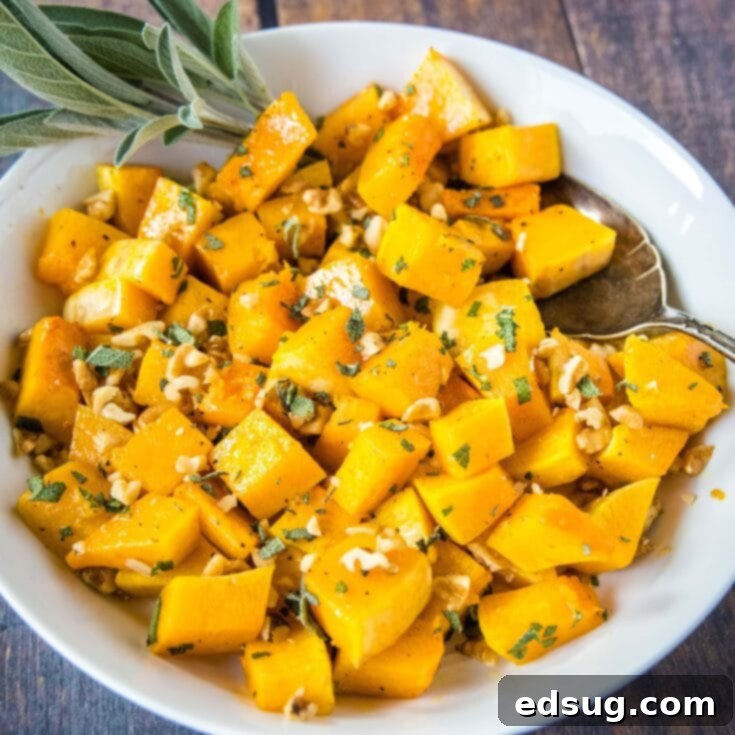
Roasted Butternut Squash with Sage and Walnuts – roasted butternut squash that is tossed with butter, sage and toasted walnuts. Great side dish for fall.
5 minutes
25 minutes
30 minutes
Ingredients
- 1 pound butternut squash, peeled and cubed
- non-stick spray
- 1/4 teaspoon salt
- 1/4 teaspoon black pepper
- 1 Tablespoon butter, melted
- 3 Tablespoons chopped walnuts, toasted
- 1 Tablespoon fresh sage, finely chopped
Instructions
- Preheat oven to 425 degrees.
- Place cubed squash onto a baking sheet in a single layer. Spray with non-stick spray. Sprinkle with salt and pepper, tossing to coat
- Bake for 20-25 minutes, until tender and slightly browned.
- Remove from oven and toss with melted butter, walnuts and sage.
- Serve immediately
Notes
Recipe Adapted from Cooking Light
Nutrition Information
Yield
4
Serving Size
1
Amount Per Serving
Calories 108Total Fat 7gSaturated Fat 2gTrans Fat 0gUnsaturated Fat 4gCholesterol 8mgSodium 173mgCarbohydrates 13gFiber 4gSugar 2gProtein 2g
Did you make this recipe?
Please leave a comment on the blog or share a picture on social media!
I created a fun group on Facebook, and I would love for you to join us! It’s a place where you can share YOUR favorite recipes, ask questions, and see what’s new at Dinners, Dishes and Desserts (so that you never miss a new recipe)!
Be sure to follow me on Instagram and tag #dinnersdishes so I can see all the wonderful DINNERS, DISHES, AND DESSERTS recipes YOU make!
Don’t miss out on any delicious inspiration! Be sure to follow me on my social media channels, so you never miss a post!
Facebook | Twitter | Pinterest | Instagram
